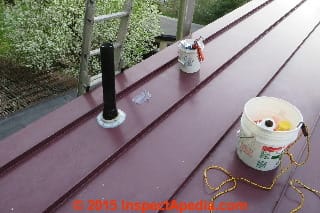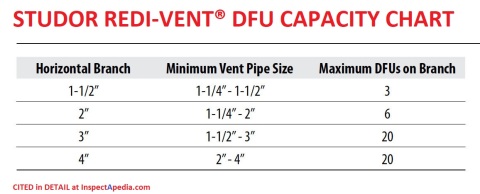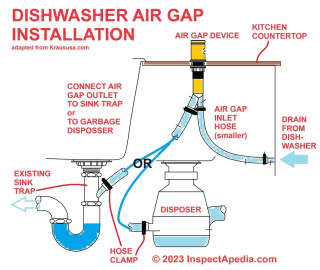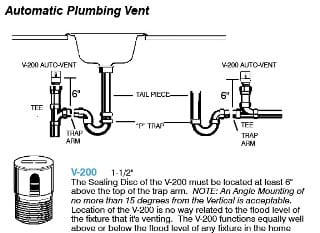 Air Admittance Valve / Studor Vent® Installation
Air Admittance Valve / Studor Vent® Installation
- POST a QUESTION or COMMENT about plumbing air admittance valves, studor vents, AAVs, installation, codes, noise diagnosis
Air admittance valves or Studor Vents:
What is an air admittance valve (AAV) or Studor Vent® and how are they used? Air admittance valves or Studor Vents (a trade name for a specific air admittance valve brand) are often found where it is difficult or even impossible to install conventional plumbing vent piping; in other installations air admittance valves may supplement the building's existing vent piping system to avoid trip siphonage and dangerous methane gas leaks during periods of heavy water usage.
This article series defines plumbing vent system terms, distances, and functions, and other specifications and code requirements. We explain how plumbing vents work on buildings, why plumbing vent piping is needed, and what happens to the building drains when the vent piping is not working.
InspectAPedia tolerates no conflicts of interest. We have no relationship with advertisers, products, or services discussed at this website.
- Daniel Friedman, Publisher/Editor/Author - See WHO ARE WE?
Air Admittance Valves & Studor Vents: Plumbing Vents to Prevent Trap Siphonage & Methane Gas Hazards in Buildings
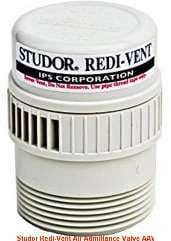 Definition of Air Admittance Valve (AAV): An AAV is a one-way valve that allows air to enter the drain to satisfy the vacuum caused by water passing down the drainage system, but that prevents sewer gases from backing up through the vent into the building.
Definition of Air Admittance Valve (AAV): An AAV is a one-way valve that allows air to enter the drain to satisfy the vacuum caused by water passing down the drainage system, but that prevents sewer gases from backing up through the vent into the building.
[Click to enlarge any image]
Above, a Studor® Redi-Vent Air Admittance Valve from IPC Corporation.
Here we define Air Admittance Valves (AAVs) and explain where and how they are used.
Question: what are those one-way vents called - used under sinks in cabinets?
(Nov 8, 2012) Jon said:
What are the one way vents called under sinks in cabinets?
Reply: air admittance valves or AAVs, or "Studor Vent"
Vacuum breaker vents or "cheater vents" or "studor vents" or more formally and properly, "air admittance valves" (AAVs) for which an example is the V-200 Jon. That's what you are asking about.
While the term "studor vent" is widely applied to describe an air admittance valve, Studor Mini-Vents as well as Redi-Vents are products of Studor Inc. & the IPS Corporation and are a brand name.
Other examples of air admittance valves (AAV s) or inline vents include models produced Keeney Mfg. Vanity Installation Kit, and the Oatey 20 DFU Sure-Vent (Oatey 39016 or 39017 and other models). Most of the AAV manufacturers offer a range of AAV models.
The Oatey SUre-Vent 39016 includes ANSI ASSE certifications stamped right on the valve top.
Article Series Contents
- AIR ADMITTANCE VALVE AAV DEFINITION
- AAV COMPARED with PLUMBING VENT - what's the difference?
- AAV CAPACITIES & SIZING GUIDE - choose the right air admittance valve
- AIR ADMITTANCE VALVE AAV REPAIR GUIDE - noises, slow drains, test procedure
- AIR ADMITTANCE VALVES CODES, STANDARDS, MANUALS
What's the Difference between an Air Admittance Valve & a Normal Plumbing Vent?
Standard plumbing vents vs. air admittance valves
Above: a conventional plumbing vent stack termination above the roof line.
If a plumbing drain is not vented to the atmosphere drain performance is likely be slow and noisy. Worse, the vacuum created by water passing through the drain waste piping system can cause water to be siphoned out of plumbing fixture traps. The loss of that trap water will in turn permit potentially explosive sewer gases to enter the building.
Standard Plumbing Vents
Typical "standard" plumbing systems include a plumbing vent pipe that passes up through the building roof and terminates above it.
- Standard plumbing vent lets air in at the rooftop:
When a sink, toilet, shower or tub or similar plumbing fixture empties into its drain system in a standard plumbing arrangement, the vacuum that would be caused by water running down the drain pipe is relieved by air that enters the piping system through the plumbing vent stack.
If we did not relieve that vacuum pressure in the drain line the drain would pass wastewater poorly, slowly, and often with a bubbling or glub glub noise.
At PLUMBING VENT NOISE we also describe Air admittance valves, studor vents, vacuum breaker valves, in-line vents, or the V-200: these products are used in both new construction (where permitted by the local plumbing inspector) and as a retrofit where a building plumbing fixture is having drain problems such as trap siphonage because the fixture is not vented or not adequately vented. - Standard plumbing prevents sewer gas from exiting by use of plumbing traps:
Sewer gases that enter the waste piping system are blocked from passing out through a sink, shower or tub drain by water in the "U" portion of the drain trap, typically a "P-trap". Sewer gases are blocked from passing out through the toilet base by water in the toilet. - Plumbing guidelines and rules define the allowable distance between any plumbing fixture and the plumbing vent stack; if a fixture is located too far from the vent, its drainage may be poor and there is risk of plumbing trap siphonage and dangerous sewer gas release in the building.
Air Admittance Valves vs "Cheater Vents"
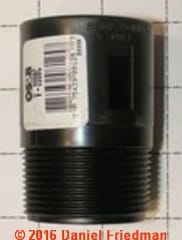 Where a conventional plumbing vent system is not available or not feasible the local plumbing inspector may permit an air admittance valve to be installed.
Where a conventional plumbing vent system is not available or not feasible the local plumbing inspector may permit an air admittance valve to be installed.
An air admittance valve is designed to allow air in to the drain piping system to which it is connected whenever pressure in the drain system is below atmospheric pressure outside the valve.
Photo: an older style "cheater vent" that is spring-operated
Watch out: the "Cheater Vent" shown above uses an internal spring that opens and closes the DWV seal. Studor, in their TECHNICAL MANUAL (cited and linked below) point out that this type of air admittance valve, or "old style" valve is not legal and does not meet any of the plumbing codes.
It may also be unsafe as a weakened or jammed or broken spring in the valve can lead to a failure that admits dangerous sewer gases into the building.
[Click to enlarge any image] Shown above: an older (now obsolete but still sold) V-200 air admittance valve
- Air admittance valve (AAV) lets air in at the valve opening: the vacuum created by water passing down the drain system opens a valve in the AAV to permit air to enter the drain system, thus satisfying or relieving the vacuum, both to improve drainage and avoid drain noises.
- The AAV closes when there is no vacuum in the drain system - that is when wastewater is not passing down the drain, preventing sewer gases from passing back up the drain system and out through the AAV.
- Air admittance valves are located close to the fixture they serve, and are placed above the drain line as well as 6" above the P-trap weir as shown in the V-200 AAV installation instructions illustrated below.
Air admittance valves (AAVs) also have to withstand the positive pressure that can occur in some public sewer systems, in forced-main public or private sewer or septic systems, in plumbing drain systems using a sewage ejector pump, or in a blocked private septic system or in systems located in hilly terrain.
Where high sewer gas pressures are anticipated, the sewer piping system should include a vent to the building exterior. (Studor 2016)
Some plumbing literature describes AAVs as P.A.P.A. devices. However they are different.
An AAV admits air into the system when under negative pressure. A P.A.P.A. or Positive Air Pressure Attenuator (described in more detail below) handles temporary back-pressures or positive air pressures in the drain/waste/vent piping system.
And some suppliers (National Builders Supply) recommend locating AAVs or PAPA devices throughout the plumbing system to improve drain performance by handling variations in air pressure in the drain-waste-vent system (DWV system), and to avoid trap siphonage.
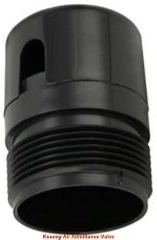 Watch out:
If you smell sewer gases in your building conditions could be dangerous (risking a methane gas explosion) or unsanitary.
Watch out:
If you smell sewer gases in your building conditions could be dangerous (risking a methane gas explosion) or unsanitary.
See REMEDIES for SEWER ODORS, PLUMBING and
also see ODORS GASES SMELLS, DIAGNOSIS & CURE.
Air Admittance Valves retail for prices between about $6.00 and $32.00 U.S.D.
Shown just above is a black plastic mechanical air admittance vent from Keeney and retailing about $6. You'll note that it looks a bit like the V-200 shown above.
Watch out: mechanical or spring-operated AAVs are not IPC code compliant and are not recommended.
Below: a Studor® Mini-Vent Air Admittance Valve (Code-Compliant).
However this Studor vent may not have been installed sufficiently high above the horizontal drain line. Details are given in the Studor Technical Manual and vent installation instructions provided here.
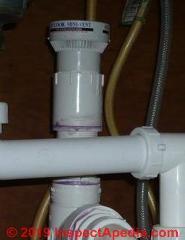 According to Studor, the company's Air Admittance Valves (available in several models and capacities) open when the drain system senses negative pressure as low as 0.1 psi, but will remain closed at 0 psi or above.
According to Studor, the company's Air Admittance Valves (available in several models and capacities) open when the drain system senses negative pressure as low as 0.1 psi, but will remain closed at 0 psi or above.
This vent is designed to open when the plumbing fixture(s) it serves are draining, thus allowing air to enter the drain waste vent system.
The Studor vent AAV closes (by gravity alone, no springs), when there is no wastewater flowing through the system, thus preventing sewer gas from passing up the drain or vent into the building.
According to Studor "This style air admittance valve is not recognized as a mechanical vent in the International Plumbing Coder (IPC)." - op. cit.
Excerpting from the Studor manual:
Because AAVs are either at or very near the Point Of Need (PON) for air, and thanks to their reaction times, a system utilizing STUDOR AAVs is capable of balancing its internal pressure much more efficiently, without trap movement or depletion than open pipe vent systems.
This is particularly true in large commercial applications where the air needed to balance the system after each occurrence is drawn from far away points and thus require substantial time to reach the Point Of Need (PON). - op. cit.
Air Admittance Valve / Studor® Vent Sizing
Air admittance valves (AAVs) or if you're using the "Kleenex" form of the term, Studor Vents are sold in various sizes or venting capacities.
Air admittance valve capacity is the measure of the volume of wastewater and its flow rate that the valve can handle while preventing trap siphonage and methane gas hazards.
If building wastewater flows exceed the rating of the AAV then it is inadequate and the building may be unsafe as water may siphon from traps and explosive methane gas could enter the building. AAV manufacturers such as Studor® typically describe air admittance valve sizing or AAVs used in a combination of installation points to match building size: a rough estimate of the actual drain flow.
Oatey rates their AAVs in DFUs and provide four AAVS at sizes of 5, 20, 160 and 500 DFUs while some other manufacturers such as Studor describe products in flow rates of wastewater in liters per second.
See PLUMBING DRAIN FIXTURE UNITS DFUs for an explanation of plumbing vent Drain Fixture Units or DFUs, and for an explanation of how DFUs are calculated and used in sizing drain waste vent piping including the selection of a proper air admittance valve or AAV sizing.
Example AAV Size Ratings in DFUs or in Liters/Second
- Oatey's Sure-Vent intended for 1 1/2 to 2" drain piping is described (at Home Depot) as in compliance with ASSE Standards 1050 and 1051, for use as a secondary vent, rated to handle up to a 3" drain pipe.
- Oatey
- Studor's Mini-Vent™ - 7.5 liters/second at 250 pa (10 pa = 1 mm water gauge). This vent can handle up to 160 DFUs on a single plumbing vent branch or up to 24 DFUs on a plumbing vent stack.
Studor's Mini-Vent™ is used for venting a single plumbing fixture or a small group of plumbing fixtures such as in a residential kitchen or bath. A residential kitchen sink drain also serving a dishwasher should be fine with the smallest AAV size. - Studor®'s Maxi-Vent™ - 32 liters/second at 250 pa (10 pa = 1 mm water gauge)
Studor®'s Maxi-Vent™ is a high capacity air admittance valve that protects trap seals throughout the drainage system of larger buildings. Used alone and installed as the manufacturer directs, the Maxi-Vent™ can handle plumbing drain venting requirements for a typical low rise residential building of three or four floors in height. - In high rise buildings up to 10 floors Studor®'s Maxi-Vent™ is combined with the company's Mini-Vent™ installed at individual fixtures
- In high rise buildings taller than 10 floors, Studor provides a Studor System venting design of highest capacity.
Illustration above: Studor's Mini-Vent® DFU (Drain Fixture Unit) sizing chart from the STUDOR PRODUCTS MANUAL cited and linked-to in this article. Studor's Tec-Vent® has the same DFU capacity.
Other Studor brand AAVs vary in DFU capacity - more charts are given below.
The Studor REDI-VENT® (in the same manual as cited above ) is installed on a 1 1/2" or 2" drain pipe; on a 4-inch horizontal branch the maximum number of DFUs it can support up to 20 DFUs.
The Studor MAXI-VENT® is installed on 3" or 4" pipes, can be used outdoors, and can vent fixtures according to the table below:
Dishwasher Air Gap AAVs
The Dishwasher Air Gap shown here is another type of air admittance valve needed at dishwasher installations if the dishwasher drain hose cannot be routed above the flood rim of the sink to whose trap the dishwasher drain will be connected.
Details are at DISHWASHER INSTALLATION & REPAIR
...
Reader Comments, Questions & Answers About The Article Above
Below you will find questions and answers previously posted on this page at its page bottom reader comment box.
Reader Q&A - also see RECOMMENDED ARTICLES & FAQs
On 2023-03-29 by InspectApedia Publisher
@Anonymous,
Thank you for the feedback, I'm so glad we could be helpful.
Your questions help us too.
Working together helps us both.
On 2023-03-29 by Anonymous
@InspectApedia Editor , Thank you for your prompt response. This was very helpful, I'm in Oregon using UPC and specialty code for AAV which states to go by specs given by the manufacturer for distance, so the diagram is perfect!
On 2023-03-28 by InspectApedia Editor - what is the allowed distance between an air admittance valve and the fixture
@Eleanor,
Yes, and thanks for a helpful question: what is the allowed distance between an air admittance valve and the fixture.
You'll see that the distances for AAVs are given not from the "fixture" as the size and dimensions of plumbing fixtures varies.
Instead it's given as a distance from an existing plumbing drain feature like the fixture's drain and trap or a nearby plumbing vent.
These distances will vary depending on the size of your particular AAV or Redi-Vent and other details that should be in the installation instructions.
Below is a horizontal distance table from Studor - one of the detailed installation manuals for AAVs / Air Admittance Valves that we provide at AIR ADMITTANCE VALVES CODES, STANDARDS, MANUALS
You'll see that the maximum distance depends on the drain size (diameter) and uglier, also depends on which plumbing code you're going to respect: the Uniform Plumbing Code UPC or the International Plumbing Code IPC.
I suggest, if you don't know anything else, stick with the UPC because those tighter constraints are an assurance of least-likely to have drain trouble.
By the UPC, if your drain diameter is 1 1/4: the AAV can be 2'6" away horizontally - and also has to be located vertically as described in the instructions.
For a 1 1/2" drain the AAV can be 3'6" away.
See the table below for other drain pipe diameters.
Let me [DF - I'm not a chatbot] know if you need more help.
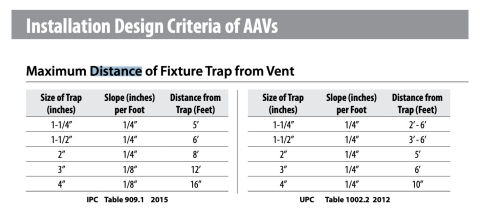
On 2023-03-28 by Eleanor
Is there a max distance that the redi-vent can be from the actual fixture?
On 2023-03-23 by InspectApedia Editor - Can I remove my studor valve and use the open line for discharge from my washing machine?
@Lee Jones,
Short answer: No what you propose is potentially unsafe.
Detailed answer with explanation:
"Can" in the sense of physically possible and in the sense that the drain might work = yes.
"Should" is another question that we can't answer for sure but I can pose some questions for you to consider.
The fact that the Studor vent is above the flood rim of the utility sink is helpful as it means that the sink or water drained into it should not back into the vent.
And if you remove the vent, that won't harm drainage - it simply lets more air into the drainline, while giving up on a check valve built into the vent whose job is to prevent possible back-venting of not just smelly, but potentially dangerous sewer gases back into the building.
I'm concerned that if you remove this air admittance valve and thus the check valve feature, conditions that you don't anticipate could back vent explosive methane into the building.
Usually a Studor vent or AAV is positioned to permit air to enter a drain line "downstream" from the fixture trap - you can see that on the illustrations above on this page.
That means that there is NO water seal to prevent sewer gases from backing up into the building should you remove the Studor vent and simply use the vertical stand pipe as a drain connector for a washing machine.
DO NOT DO THAT - don't remove the vent if that leaves an un-trapped drain line into which you're sending your washer drainage.
Instead you would either drain the washer right into the utility sink itself - a common practice
or
To the existing or another convenient drain line you'd add a vertical drain *with a proper trap at its bottom* and properly-sized to handle the washer drainage volume and rate.
On 2023-03-23 by Lee Jones
Can I remove my studor valve and use the open line for discharge from my washing machine? The washing machine is in an untreated shop area that also has a floor drain. I do not detect gas odors from floor drain. The studor valve is located behind and above a utility sink.
On 2023-03-07 by InspectApedia Editor - complete inspection needed to plan where and how much additional venting or AAVs to add
@RF,
It sounds as if the AAV size and location was not able to provide sufficient venting for all of the plumbing fixtures involved.
I'd want to have a more complete inspection of the building's drain, waste, and vent piping to plan where and how much additional venting or AAVs to add.
On 2023-03-07 by RF
Hi, bought an old house. I noticed a smell in the bathroom and realized there wasnt a trap on the tub's drain. It goes down into the basement floor, (into the main line, i assume), There are no vents in this old house and i think they were using the tub drain as a vent of some sort.
So i added a trap and an AAV . Months later i had to call a plumber because the toilet wouldnt flush, and despite snaking it out twice, along with the main out, it still wouldnt flush, Until I removed the AAV. so i have kept it off until i figure something out. Do you think your AAV would work better in this scenario?
On 2023-01-19 by InspectApedia Publisher
@Bill,
It does sound as if the bathroom sink venting is inadequate so it's reasonable to try adding an air admittance valve there.
On 2023-01-19 by Bill
My washing machine drains via an injection pump which empties the bathroom sink trap and emits sewage gases into the bathroom. I realize I can't use an AAV on the ejection drain line because it is under positive pressure. Would adding an AAV prior to the bathroom sink trap solve this issue?
On 2022-11-28 by InspectApedia (Editor)
@Gregoryleepickard,
No
On 2022-11-28 by Gregoryleepickard
Is it imperative to connect AAV to roof vent?
On 2022-11-02 by InspectApedia-911 (mod) - if the sink gurgles when a toilet is flushed, it's because the vent system is blocked or inadequate
@Elisabeth,
In most installations, if the sink gurgles when a toilet is flushed, it's because the vent system is blocked or inadequate.
There are some additional special cases that can show up as drain noise, such as a remote drain blockage that gurgles after the toilet is flushed.
On 2022-11-02 by Elisabeth
Is the sound under the sink after toliet is flushed downstairs a plumbing vent? Or air vent?
On 2022-01-11 by Danjoefriedman (mod) - Air Admittance Valve isn't likely to be the root source of leak
@Rich,
Well you're sure asking the right question but I cannot see nearly enough from here to make a useful guess.
Look at the sink cabinets, bases, wallboard, trim, etc. for water stains, and run water one fixture at a time to see if you see a leak or drain backup.
The Air Admittance Valve isn't likely to be the root source of the problem as it's a vent on a drain, not something that would "turn on" water in the home while you're away.
On 2022-01-11 by Rich
We have house on slab in NC with island sink and were away for a few months Aug-Dec and when we returned to our house it showed water damage in kitchen and adjacent room. The carpet in the adjacent room was dry and there was minor pooling of water under the sink.
We have studor vent that appears fine and we’ve been back in the house for 5-days using kitchen sink and garbage disposal and no leaks. We filled both sinks and let drain and no issues. Any thoughts on where leak originated? Thanks
On 2021-12-01 by Inspectapedia Com Moderator
@Jane,
Thank you for a helpful AAV noise question.
Please find your question repeated along with our detailed reply now located at
AIR ADMITTANCE VALVE AAV NOISE DIAGNOSIS - above on this page
On 2021-11-30 by Jane
Why does our air admittance vent make a ticking sound
On 2021-11-26 by Inspectapedia Com Moderator (mod) - AAV protect the sink / shower from having their traps siphoned
@Daniel,
Thank you for the question I can see that I haven't and clear.
The successful use of an air admittance valve indeed depends on where the AAV is located, and of course all its size or vent capacity and the volume and distance to the drains that it is serving.
I should have said that properly- located, an AAV might protect the sink and shower from having their traps siphoned when they are in use and might protect them as well when the toilet is flushed.
You see in this article series and also in the aav installation instructions the concept of drain fixture units, DFUs, explained.
Basically the number and size and distance in bends and elbows in the piping determine how much intake venting is needed from the aav or to serve adequately.
On 2021-11-25 by Daniel
@Inspectapedia Com Moderator,
Thanks for replying so quickly.
So, from what you’re saying, I understand that an AAV under the kitchen sink would undoubtedly be beneficial.
However, I must apologize and admit that I’m a but confused about the second part - installing AAV’s under the bathroom sink.
You’re saying they would definitely siphon out the sink traps? Why would this happen? I thought the whole point of installing an AAV under a bathroom sink is so that it doesn’t siphon when I flush the toilet next to it.
I hope you understand my confusion and can perhaps help me understand better.
Again, thank you for your support!
Best,
Daniel
On 2021-11-23 17by Inspectapedia Com Moderator (mod)
@Daniel,
Thanks for the ventless plumbing system question; indeed we've seen the same thing in Mexico.
Your kitchen sink would benefit from an AAV as would each bath sink.
The bath AAV s might also admit air to help toilets and showers drain but in doing so would also be siphoning out the sink trap. But unless you can get into the wall and floor at showers we're sunk on that one.
The laundry washing machine drain, if it's large enough, will admit air around the washing machine hooked drain hose so you shouldn't need to add an AAV there.
On 2021-11-23 by Daniel
I am remodeling my home and that includes redoing the whole drain and waste system (pipes, underground, etc.) Unfortunately, the contractor didn’t install any vents (this is in Latin America) and so I’m looking for a quick and easy way to fix this. I’m just not sure how many AAV’s I need and where they need to be installed.
General specs:
- one-story house, ground level
- fixtures: 2-sink kitchen drain, laundry washing machine, and 2 full bathrooms (each with 1 toilet, 1 sink and 1 shower.)
Is one AAV strategically installed enough for the whole house? If so, what kind and where exactly? If not, can you please elaborate?
Any feedback and guidance will be useful and much appreciated.
Thanks!
On 2021-10-31 by inspectapedia.com.moderator (mod)
@Stephanie, no that would not be necessary, nor functionally useful.
On 2021-10-30 by Stephanie
Would you ever put an AAV on the outside roof vent?
On 2020-11-07 by (mod) - can an AAV be used for venting a toilet?
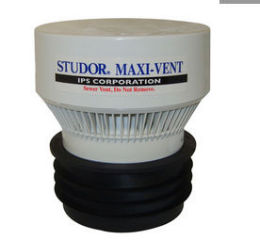 Terry,
Terry,
Yes, possibly. Take a look at the large capacity air admittance valves like the Studor Maxi-Vent shown below and capable of venting at 32 L/sec. at -250 Pa. This AAV is described as a "soil stack vent".
Here is the STUDOR MAXI-VENT PRODUCT SPECIFICATIONS SHEET [PDF]
Ron, yes.
On 2020-11-06 by terry
can an AAV be used for venting a toilet?
On 2019-06-15 by Ron
Can you have a garbage disposal with this system with an air admittance valve?
...
Continue reading at PLUMBING VENT CODES, DEFINITIONS, TYPES or select a topic from the closely-related articles below, or see the complete ARTICLE INDEX.
Or see these
Recommended Articles
- AIR ADMITTANCE VALVES AAVs - home
- AIR ADMITTANCE VALVE AAV DEFINITION
- AAV COMPARED with PLUMBING VENT - what's the difference?
- AAV CAPACITIES & SIZING GUIDE - choose the right air admittance valve
- AIR ADMITTANCE VALVE AAV REPAIR GUIDE - noises, slow drains, test procedure
- AIR ADMITTANCE VALVES CODES, STANDARDS, MANUALS
- DRAIN BACK & SNIFTER VALVE OPERATION - used to maintain air charge in a water pressure tank - not part of building drain piping
- PLUMBING DRAIN FIXTURE UNITS DFUs
- PLUMBING DRAIN NOISES
- PLUMBING VENT CODES, DEFINITIONS, TYPES
- DEFINITION of a Plumbing Stack Vent
- DIFFERENCE Between Soil Stack & Waste Stack
- DIRECT VENTED Plumbing Fixtures
- DISTANCE: vent piping be located from a plumbing fixture?
- DRAIN & VENT SIZE & DISTANCES to FIXTURES
- FUNCTION: how plumbing vent piping works
- ROUTING SPECS for PLUMBING VENTS
- VENT DISTANCES to BUILDING FEATURES
- WET VENTED Plumbing Fixture
- PLUMBING VENT REPAIR
- TAPPING NOISES in BUILDINGS
- TICKING NOISE DIAGNOSIS
Suggested citation for this web page
AIR ADMITTANCE VALVES AAVs at InspectApedia.com - online encyclopedia of building & environmental inspection, testing, diagnosis, repair, & problem prevention advice.
Or see this
INDEX to RELATED ARTICLES: ARTICLE INDEX to PLUMBING SYSTEMS
Or use the SEARCH BOX found below to Ask a Question or Search InspectApedia
Ask a Question or Search InspectApedia
Try the search box just below, or if you prefer, post a question or comment in the Comments box below and we will respond promptly.
Search the InspectApedia website
Note: appearance of your Comment below may be delayed: if your comment contains an image, photograph, web link, or text that looks to the software as if it might be a web link, your posting will appear after it has been approved by a moderator. Apologies for the delay.
Only one image can be added per comment but you can post as many comments, and therefore images, as you like.
You will not receive a notification when a response to your question has been posted.
Please bookmark this page to make it easy for you to check back for our response.
IF above you see "Comment Form is loading comments..." then COMMENT BOX - countable.ca / bawkbox.com IS NOT WORKING.
In any case you are welcome to send an email directly to us at InspectApedia.com at editor@inspectApedia.com
We'll reply to you directly. Please help us help you by noting, in your email, the URL of the InspectApedia page where you wanted to comment.
Citations & References
In addition to any citations in the article above, a full list is available on request.
- International Code Council, 500 New Jersey Avenue, NW, 6th Floor, Washington, DC 20001 Tel: 1-888-ICC-SAFE (422-7233); Fax: (202) 783-2348 International: (202) 370-1800, Email: webmaster@iccsafe.org, Website: www.iccsafe.org
- International Residential Code (IRC), for One and Two Family Dwellings, 2012 (First Printing)
Home Page: publicecodes.citation.com/icod/irc/index.htm
Citation Page:
publicecodes.citation.com/icod/irc/2012/icod_irc_2012_31_sec003.htm - International Mechanical Code (IMC), International Code Council [888] 422-7233, Op. Cit.
- International Plumbing Code (IPC) (see NPC below), Op. Cit.
- National Standard Plumbing Code, (NPC), 2009
obtained From: National Assoc. of Plumbing-Heating-Cooling Contractors in New Jersey at [800] 652-7422 or NAPHCC [800] 533-7694, [Cited by New Jersey State Department of Community Affairs]
state.nj.us/dca/divisions/codes/codreg/pdf_misc_codes/2006_nspc.pdf - New Jersey State Department of Community Affairs, Website: state.nj.us/dca/divisions/codes/codreg/
- In addition to citations & references found in this article, see the research citations given at the end of the related articles found at our suggested
CONTINUE READING or RECOMMENDED ARTICLES.
- Carson, Dunlop & Associates Ltd., 120 Carlton Street Suite 407, Toronto ON M5A 4K2. Tel: (416) 964-9415 1-800-268-7070 Email: info@carsondunlop.com. Alan Carson is a past president of ASHI, the American Society of Home Inspectors.
Thanks to Alan Carson and Bob Dunlop, for permission for InspectAPedia to use text excerpts from The HOME REFERENCE BOOK - the Encyclopedia of Homes and to use illustrations from The ILLUSTRATED HOME .
Carson Dunlop Associates provides extensive home inspection education and report writing material. In gratitude we provide links to tsome Carson Dunlop Associates products and services.


